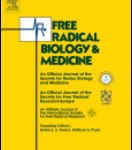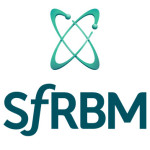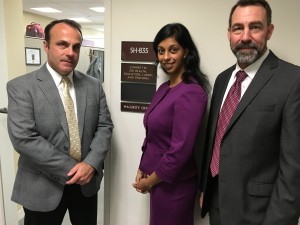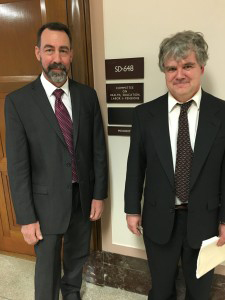Click here for view the full article in Free Radical Biology & Medicine
 In view of the global prevalence of obesity and obesity-associated disorders, it is important to clearly understand how adipose tissue forms. Accumulating data from various laboratories implicate that redox status is closely associated with energy metabolism. Thus, biochemical regulation of the redox system may be an attractive alternative for the treatment of obesity-related disorders. In this work, we will review the current data detailing the role of the redox system in adipocyte differentiation, as well as identifying areas for further research. The redox system affects adipogenic differentiation in an extensive way. We propose that there is a complex and interactive “redox chain,” consisting of a “ROS-generating enzyme chain,” “combined antioxidant chain,” and “transcription factor chain,” which contributes to fine-tune the regulation of ROS level and subsequent biological consequences. The roles of the redox system in adipocyte differentiation are paradoxical. The redox system exerts a “tridimensional” mechanism in the regulation of adipocyte differentiation, including transcriptional, epigenetic, and posttranslational modulations. We suggest that redoxomic techniques should be extensively applied to understand the biological effects of redox alterations in a more integrated way. A stable and standardized “redox index” is urgently needed for the evaluation of the general redox status. Therefore, more effort should be made to establish and maintain a general redox balance rather than to conduct simple prooxidant or antioxidant interventions, which have comprehensive implications.
In view of the global prevalence of obesity and obesity-associated disorders, it is important to clearly understand how adipose tissue forms. Accumulating data from various laboratories implicate that redox status is closely associated with energy metabolism. Thus, biochemical regulation of the redox system may be an attractive alternative for the treatment of obesity-related disorders. In this work, we will review the current data detailing the role of the redox system in adipocyte differentiation, as well as identifying areas for further research. The redox system affects adipogenic differentiation in an extensive way. We propose that there is a complex and interactive “redox chain,” consisting of a “ROS-generating enzyme chain,” “combined antioxidant chain,” and “transcription factor chain,” which contributes to fine-tune the regulation of ROS level and subsequent biological consequences. The roles of the redox system in adipocyte differentiation are paradoxical. The redox system exerts a “tridimensional” mechanism in the regulation of adipocyte differentiation, including transcriptional, epigenetic, and posttranslational modulations. We suggest that redoxomic techniques should be extensively applied to understand the biological effects of redox alterations in a more integrated way. A stable and standardized “redox index” is urgently needed for the evaluation of the general redox status. Therefore, more effort should be made to establish and maintain a general redox balance rather than to conduct simple prooxidant or antioxidant interventions, which have comprehensive implications.
— Published
Dear “Laboratory Personnel Everywhere,”
Help! I am trying to find the perfect laboratory to join for my doctoral training. Every person in every laboratory I have worked in has offered me advice to help me decide on what laboratory to join, but it’s been information overload. Do you have a top 5 list of things to look for in the perfect laboratory?
Sincerely,
“Looking for a Lab”
Dear “Looking for a Lab,”
 This is definitely a tough one. First, it is important to remember that “one lab does not fit all.” I don’t think there are any hard and fast rules but these our top 5 tips to consider when picking your perfect laboratory family.
This is definitely a tough one. First, it is important to remember that “one lab does not fit all.” I don’t think there are any hard and fast rules but these our top 5 tips to consider when picking your perfect laboratory family.
Good luck on your search,
“Labs everywhere”
— Published
Category: SfRBM Trainee Council
The Society for Redox Biology and Medicine (SfRBM) has introduced a new logo that will improve its visual identity to redox biology scientists, policymakers, funders and partner organizations.

The new logo comes at the end of a nearly year-long process to rebrand the society to better reflect SfRBM’s status as the premier organization for oxidative and redox research. The logo will be applied to all SfRBM programs, services, and communication vehicles.
“We are thrilled to unveil this new logo,” said Neil Hogg, SfRBM President. “The logo is cleanly designed and will serve us well as we prepare for the international meeting we will host in San Francisco next year. I want to thank all those who put in extensive time to review all the options.”
SfRBM provides a forum for members to share their research through conferences and workshops, interaction with science foundations and funding agencies, and education of policy makers and health professionals.
 About SfRBM
About SfRBM
Founded in 1987, the Society for Redox Biology and Medicine (SfRBM) is an international organization of more than 1,200 scientists, investigators and clinicians who conduct research in the area of redox biology. These areas have shown explosive growth over the last decade and are now integral to major initiatives in basic, applied and translational research, including the development of new therapies in cancer, heart disease, aging and cardiovascular disease.
Free Radical Biology and Medicine and Redox Biology, published by Elsevier, serve as the two official journals of SFRBM.
— Published
 (BOSTON) – Jay Teich, former Seahorse Bioscience CEO, will receive the first ever CEO Innovator Award from the Society for Redox Biology and Medicine (SfRBM). This international award will annually recognize industry leaders who have transformed the face of scientific research in the areas of redox biology and medicine. Teich will receive the award in Boston on November 20, 2015, during SfRBM 2015, the premier event for cutting-edge research in all aspects of redox biology. Seahorse was acquired by Agilent Technologies on Nov. 1; Teich is now general manager of the Seahorse team at Agilent.
(BOSTON) – Jay Teich, former Seahorse Bioscience CEO, will receive the first ever CEO Innovator Award from the Society for Redox Biology and Medicine (SfRBM). This international award will annually recognize industry leaders who have transformed the face of scientific research in the areas of redox biology and medicine. Teich will receive the award in Boston on November 20, 2015, during SfRBM 2015, the premier event for cutting-edge research in all aspects of redox biology. Seahorse was acquired by Agilent Technologies on Nov. 1; Teich is now general manager of the Seahorse team at Agilent.
“Led by Jay, Seahorse Bioscience has been an industry leader for many years, developing innovative technologies so many others strive to achieve,” said SfRBM president Neil Hogg, Ph.D. “We are thrilled to recognize this achievement and look forward to seeing the next chapter of scientific breakthroughs as Seahorse becomes a part of Agilent.”
Seahorse Bioscience's unique technology is the perfect complement to Agilent's market-leading separations and mass spectrometry solutions. The combination of these two platforms will give scientists a more comprehensive and faster path to researching the most challenging diseases affecting humankind, including a greater understanding of redox biology, the study of electron flow through biological circuits, sensors, and switches, applicable in many areas critical to human health including cancer, heart disease, aging, cardiovascular disease and obesity.
“I am honored to receive the SfRBM CEO Innovator Award on behalf of my colleagues at Seahorse Bioscience,” said Teich. “We are committed to developing instruments and assay kits for measuring cell metabolism, tools that provide scientists a better understanding of mitochondrial function and disease.”
About SFRBM
Founded in 1987, the Society for Redox Biology and Medicine (http://sfrbm.org) is an international organization of 1,200 scientists, investigators and clinicians who conduct research in the area of redox biology. These areas have shown explosive growth over the last decade and are now integral to major initiatives in basic, applied and translational research, including development of new therapies in cancer, heart disease, aging and cardiovascular disease.
About Seahorse Bioscience, a Part of Agilent Technologies
Seahorse Bioscience XF metabolic analyzers and stress test kits are the industry standard in cell metabolism measurements. Scientists worldwide are using Seahorse technology to advance their research in understanding the role of cell metabolism. Seahorse is headquartered in Billerica, Massachusetts, U.S., and has regional offices in Copenhagen, Denmark, and Shanghai, China. For more information, visit www.seahorsebio.com. Agilent Technologies Inc., a global leader in life sciences, diagnostics and applied chemical markets, is the premier laboratory partner for a better world. Agilent works with customers in more than 100 countries, providing instruments, software, services and consumables for the entire laboratory workflow. The company generated revenues of $4.0 billion in fiscal 2014 and employs about 12,000 people worldwide. Agilent marks its 50th anniversary in analytical instrumentation this year. For more information, visit www.agilent.com.
— Published
On October 21-22, SfRBM leadership held 12 meetings on Capitol Hill in Washington D.C. to introduce key Congressional offices to the society and discuss important issues impacting members, including increased NIH funding, diversity and public engagement in science.
 SfRBM met with senior staff of the Senate Committee on Health, Education, Labor and Pension (HELP), which has jurisdiction encompassing most of the agencies, institutes, and programs of the Department of Health and Human Services including the NIH. SfRBM also met directly with Senator Chuck Grassley, Senator Joni Ernst, Congressman Dave Loebsack to name a few. One goal of these meetings was to build relationships between key Congressional offices and SfRBM. While SfRBM is a member of the Federation of American Society for Experimental Biology (FASEB), which does an amazing job raising awareness of legislation impacting the scientific community, they do not promote or raise awareness about SfRBM specifically.
SfRBM met with senior staff of the Senate Committee on Health, Education, Labor and Pension (HELP), which has jurisdiction encompassing most of the agencies, institutes, and programs of the Department of Health and Human Services including the NIH. SfRBM also met directly with Senator Chuck Grassley, Senator Joni Ernst, Congressman Dave Loebsack to name a few. One goal of these meetings was to build relationships between key Congressional offices and SfRBM. While SfRBM is a member of the Federation of American Society for Experimental Biology (FASEB), which does an amazing job raising awareness of legislation impacting the scientific community, they do not promote or raise awareness about SfRBM specifically.
 SfRBM leaders and staff who participated included Neil Hogg, Rick Domann, Sruti Shiva, Eric Kelley, Kent Lindeman and Brent Carney, the society’s communications and public affairs partner.
SfRBM leaders and staff who participated included Neil Hogg, Rick Domann, Sruti Shiva, Eric Kelley, Kent Lindeman and Brent Carney, the society’s communications and public affairs partner.
In talking to members of Congress about ways to increase NIH research funding, there was pledged support for this initiative, however no real solutions laid out for how to fund it. Congressmen James Sensenbrenner’s office indicated they would not vote in favor of any NIH bill that did not clearly identify the funding source. Senator Robert Casey’s office stated that the pharmaceutical industry, who benefits greatly from the bench science resulting from NIH funding, doesn’t seem to prioritize the importance of NIH funding to support this research when they are speaking with legislators.
 After meeting with the Senate HELP Committee, we came away with guarded optimism. The Committee is currently working on an “Innovation Bill” that will be the Senate companion to the 21st Century Cures Act which passed the House earlier this year. This bill will focus on three sectors, NIH research, FDA research and Health IT. While the bill is set to be introduced in the next couple weeks, making our visit extremely timely, it is unclear if it will contain increased funding for the NIH. Senator Patty Murray, in her role as Committee Ranking Member, indicated to us that such funding is a “must have” in the legislation.
After meeting with the Senate HELP Committee, we came away with guarded optimism. The Committee is currently working on an “Innovation Bill” that will be the Senate companion to the 21st Century Cures Act which passed the House earlier this year. This bill will focus on three sectors, NIH research, FDA research and Health IT. While the bill is set to be introduced in the next couple weeks, making our visit extremely timely, it is unclear if it will contain increased funding for the NIH. Senator Patty Murray, in her role as Committee Ranking Member, indicated to us that such funding is a “must have” in the legislation.
Overall, we were thrilled with the reception we received and the opportunity this gives us in the coming years. Given the timing of the legislation in the HELP Committee and the FY2016 budget, our visit couldn’t have come at a more pivotal time. As one of the benefits you receive as an SfRBM member, we feel this representation in Washington was extremely beneficial for our organization, its members and the issues so many of us hold dear. We look forward to continuing to build the relationships that were started in DC last week, to the benefit SfRBM members in future years.
Sincerely,
Neil Hogg, Ph.D.
Medical College of Wisconsin
SfRBM President
— Published
Category: Redox Biology